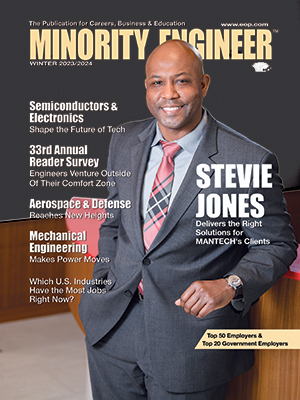| |

Minority Engineer Magazine, launched in 1979, is a career- guidance and recruitment magazine offered at no charge to qualified engineering or computer-science students and professionals who are African-American, Hispanic, Native American, and Asian American. Minority Engineer presents career strategies for readers to assimilate into a diversified job marketplace.
This magazine reaches minority engineers nationwide at their home addresses, colleges and universities, and chapters of student and professional organizations.
If you are an engineering student or professional who is a member of a minority group, Minority Engineer is available to you FREE!

|
|
 Minority Engineer
Minority Engineer
» Featured Articles
» Subscription Information
» Reader Survey
» Companies Actively Recruiting

Engineers Find A Professional 'Hone' In Government Work
Barbara Woodworth
For engineers interested in a government career, the number of agencies from which to choose is vast. According to the Partnership tor Public Service, a non-profit, non-partisan organization “that teams up with federal agencies and other stakeholders to make our government more effective and efficient,” the mission is “to revitalize our federal government by transforming the way government works and inspiring a new generation to serve.”
Case in point - government salaries - while not always equivalent to the private sector - government initiatives and benefits are often sufficient enough to woo service-minded individuals.
As tor the military, there is no greater way to demonstrate service to your country. Like the government, engineering-focused jobs vary from branch to branch, and within each branch, as well. But regardless of the position or capacity in which one serves, the military is the optimum employer tor demonstrating commitment.
DENNIS WOODFORK, GODDARD SPACE FLIGHT CENTER
When Dennis Woodfork goes to work each morning, he does something few others ever get to do. As chief technologist for the mission engineering and systems analysis division at Washington, DC-headquartered, Goddard Space Flight Center (www.nasa.gov), Woodfork leads a talented, innovative team of technologists whose task it is to solve technical-based problems never posed – or solved – before. ”That’s what I love most about this job,” says Woodfork, who’s worked for the past eight years at Goddard, which employs 10,000 people.
A graduate of the U.S. Naval Academy, Woodfork expected to accept a naval officer commission upon graduating. An unexpected diagnosis of scoliosis, however, redirected his plans to the Air Force, where he served for on active duty for seven years. He now continues as a lieutenant colonel in the Air Force Reserves. Having completed a master’s degree in astronautical engineering from the Air Force Institute of Technology, he also earned a MBA from the University of Maryland, College Park, Robert H. Smith School of Business in July 2015 while serving in his current role of division chief technologist.
Starting at Goddard as an aerospace engineer assigned to the spacecraft navigation and mission design branch enabled Woodfork to realize his childhood dream of working in the civil space arena. “I knew that was what I wanted since the get-go, and I credit my parents with fostering my ambition. At summer space camp I met Charlie Bolden, then an astronaut and now leader at NASA. Over the years I followed in his footsteps,” he mentions.
From an entry-level position, Woodfork next supervised the navigation and mission design branch until he was tapped by the Deputy Assistant Secretary of Defense to work at the Pentagon on space policy, involving the clean-up of space debris. Returning to Goddard, he focused on space protection, dealing with ways to protect spacecraft and ground systems from all manner of manmade threats.
In 2014, he accepted his current position where, in addition to serving on several technology development teams, he leads a technical council that matches scientific needs with technology - building “road maps” re quired to carry out future missions in space. “In addition to other complex duties, my division is in charge of all aspects of guidance, navigation and control, and systems engineering for Goddard, a NASA field center,” he says. “It’s our job to ensure that all ‘pieces of the puzzle’ come together and generate success.”
He compares this arena to the early days of westward land expansion. “The field of delivering novel innovations for space, whether for government or private endeavors, is expanding exponentially,” Woodfork says. Confident that now is the time for those interested in exploring space for exploration sake, and profitable enterprise, he asks rhetorically, “Where else but in this sector can you be involved with exploring worlds that have never been visited before?”
He urges those with imagination, curiosity and a passion for knowledge to learn several computer languages – the key to unlocking many engineering problems.
Woodfork’s advice for all engineers is not to be afraid of taking risks. “If your job is too easy, it’s time for a change. You can only grow if you are challenging yourself,” he remarks, adding that working in a collaborative environment, and taking into consideration all thoughts presented by a diverse group of people, is essential for identifying engineering solutions – especially those that touch upon situations previously never encountered. This is the approach to mentoring on which Woodfork thrives, both when coaching his elementary school computer coding team and with his own four children.
 » Feedback for the Editor
» Feedback for the Editor
» Request Article Copy
|
|